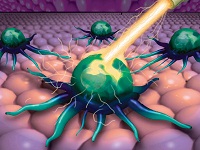well-dressed particles
stories and images by Neil Caudle
Thompson Mefford’s group gets down and dirty with rust. They like it that way.
 One of the big questions in nanoscience is: What happens to nanoparticles released into the environment? Thompson Mefford (left) and Brian Powell (right) have been tracking the movement of several kinds of nanoparticles by using containers of natural soil exposed to weather. Early results indicate that the coating on a particle influences its movement.
One of the big questions in nanoscience is: What happens to nanoparticles released into the environment? Thompson Mefford (left) and Brian Powell (right) have been tracking the movement of several kinds of nanoparticles by using containers of natural soil exposed to weather. Early results indicate that the coating on a particle influences its movement.As any teenager might guess, what a particle wears affects its game. Thompson Mefford’s lab turns out designer wardrobes for nanoparticles that can, for instance, target a receptor site or smuggle things inside a cell. Starting with what Mefford calls “glorified rust,” he and his group of five graduate students and eight undergraduate students create iron oxide nanoparticles as small as molecules—cubes and rods and spheres and more—and dress them up for work.
“We’re a materials chemistry group in hiding,” Mefford says.
Why would a chemistry group hole up in an optics lab? Mefford needs advanced optics to track and analyze the particles he makes, and many new technologies marry particles with optics. Mefford’s lab, for example, uses nanoparticles to form a diffraction grating—a patterned surface that splits light into several beams heading in different directions. Mefford is excited about a grant he received from the National Science Foundation to develop methods for making various optical materials on an industrial scale.
Mefford’s knack for creating designer particles has made him lots of friends outside his field, which is materials science and engineering. Biologists use his nanoparticles to test treatments for Legionnaire’s disease, clean away biofilms, and infiltrate bacteria. A physicist programs an old-style hard disk and bathes its surface with Mefford’s nanoparticles, which are attracted to the magnetic poles; the particles and program can then be fixed in a polymer film and peeled away like adhesive tape—a step toward computing with flexible fabrics. And a collaboration with Clemson’s Warren E. Lasch Conservation Center has produced a method for etching the silica surface of computer chips or photovoltaic cells with hot, mildly caustic water instead of the usual method, which applies very hazardous hydrofluoric acid.
But the bulk of Mefford’s work is biomedical, and his group devotes much of its attention to killing tumor cells with heat, imitating the natural fevers that fight infections. German clinics have already begun to test an early version of this technique in human patients, but the nanoparticles in those trials are rudimentary, Mefford says, and the technology faces serious hurdles. His lab is refining the particles to make them more effective, so that fewer are needed.
Nanoparticles are flowing into medicine from multiple directions and are already widely used as magnetic agents for high-contrast images in MRI diagnostics. Steven Saville, a Ph.D. student in Mefford’s lab, has discovered that the contrast agents sometimes begin to “crosstalk,” interacting in ways that suppress the contrast. By changing the particles’ coating, he can manage the conversation.
All such studies require a steady supply of nanoparticles, which are not easy to make or dispense. This year, undergraduate students on a Creative Inquiry team designed and built a plumbing system that pipes nanoparticles through a stainless steel coil to a high-tech faucet, where researchers can tap them at will. “Some people can’t believe that undergraduates could make something like this,” Mefford says. “They can.”
The idea of free-flowing nanoparticles— even those confined to a lab—can worry those of us who wonder how nanoparticles might threaten our health or the environment. The truth is, Mefford says, we do not know what the risks might be. He and two colleagues—Chris Kitchens in chemical engineering and Brian Powell in environmental engineering—are studying the fate of various nanoparticles in soil, using a device called a lysimeter. Powell has used the same device to track the radionuclides associated with radioactivity. Read After Fukushima.
“Our hypothesis is that the surface chemistry of the particles basically dictates where these things go,” Mefford says.
If that’s the case, we can ask his chemistry group in hiding to tell us what a responsible nanoparticle should and should not wear.
Fiber optics spread the Internet around the globe, but the science of light is just warming up. Go back to Material advantage and the power of light.
This is what Eric Johnson has to explain, outside of work. But what he does make, with his team of savvy students, takes vision.
His was not the usual path to a job fighting cancer. Stephen Foulger was a California dude, a surfer and gear head who built motorcycles.
For now, we can introduce you to only a few of the people at COMSET, and we’ll have to save a number of researchers for issues to come. Or visit the COMSET website.
O. Thompson Mefford is an assistant professor of materials science and engineering in the College of Engineering and Science.









